Texagonian
CHOOSE YOUR TITLE
Holy crap @delta9nxs , I would love to make one of these systems for my grow. Reminds me of an automated Dutch bucket system in some ways. Good stuff sir. Still do work in Oregon? Portland???✌?
i haven't lived in oregon for the last 3 years but i have a lot of clients there. i mean consulting clients. these are people i have designed rooms and systems for or have given them advice.Holy crap @delta9nxs , I would love to make one of these systems for my grow. Reminds me of an automated Dutch bucket system in some ways. Good stuff sir. Still do work in Oregon? Portland???✌?
Quite the resume and skill set. How small can this kind of system be scaled for small medical growers that would like to up their game so to speak? I’ve grown in hydro a few different ways and have had the explosive growth and killer yields but at some point have also ended up with root issues regardless of precautionary measures etc.i haven't lived in oregon for the last 3 years but i have a lot of clients there. i mean consulting clients. these are people i have designed rooms and systems for or have given them advice.
i lived in eugene for 5 years but worked all over the state and nor cal also.
i can do all the design work over the net though so travel is not necessary.
usually i start with a schematic of the space, description of insulation, power available, water quality, etc.
budget is critically important on startup.
most are underfinanced.
i have financial training and have held a brokers license.
in the cbd hemp flower room in nashville i started with a 10k sq ft concrete warehouse that just had enough juice for a few overhead lights.
i supervised the installation of an 800 amp service and designed all electrical maps. i designed and supervised the buildout of all plumbing.
the facility runs very smoothly with one rack being taken down every week and one rack being loaded. perpetual gives regular paydays.
the cool thing about automation is that it radically reduces payroll.
my 2500 sq ft medical facility in oregon produced 7-8 lbs a week with just 2 full-time employees. and it wasn't hemp either!
contrast that to a 5000 sq ft recreational facilty down the road where the guy had a small army of baboons hauling water twice a day to each plant.
if you build the facility right then you can train technically able people and pay them a little more to retain them.










the math shows the 6x6x12 container at 432 cu in which is 1.87 gals. i think a single 1.5" tailpiece 6" long would work fine.So if I were using some old square buckets as the lower reservoir, how long of a tailpiece would you run from the upper growing/ medium filled container? 6x6 square, 12-14 inch tall roughly.
wrong kind of tube. below is what you want. it already has a lip on it that will hold it in place. it is 1.5" od not 1.5" id. it is designed to fit into a 1.5" pvc pipe.I’ve got a huge stick of 1.5” pvc left over from another project. Perfect!

Thank you for that. I want to automate. I wouldn’t be able to hand water frequently enough.i just took a few pics of one of mine.
the tube is not glued in so i pulled this one part way out so you could see the lip.
use a regular 1.5" hole saw on a drill. i drill a pilot hole first and use the cheap harbor freight hole saws because they don't tear up plastic.
next pic shows one pulled all the way out for use and one new one.
the last pic shows one way to retain the media in the tube. 7/32" holes and 4" zip ties. i then put a piece of screen over them from the inside if i'm using a medium that will fall through. most fiber-type cocos will just sit on the crossed zip ties.
this alone is good up to about 2 gals. larger containers need larger tubes that need to be built from other pvc parts.
the 7 gal tubs used in oregon require 3" tubes.
are you going to hand water or automate?
Can you explain the plumbing for me in a little more detail. I was observing the pictures from the Oregon room and i somewhat understand but would enjoy more explanation/detail. Thank youmy first plant in one of these was only bottom watered, like a sip, and it produced a beautiful little plant.
then i started top watering in addition to sub-irrigation. maybe once a day. and got a bigger plant.
but when i automated the top watering in combination with 24/7 sub-irrigation things started blowing up.
there is a synergistic reaction in this device. a reaction that is greater than the sum total of it's parts.
once i discovered that i began playing around with frequency and interval and different mediums.
there is a bunch of theory involved but you don't need to be a hydro guru to operate it.
if you build it right it operates itself. you just watch.
you know the usual hydro scene;
super hydro man wearing a gun belt with his meters in fast draw holsters.
poised over his grow day and night to deal with all the emergencies that he know's are coming.
nothing happens fast in this device. all chemical changes are slower occurring and therefore you have more time to observe and react. it's truly slo-mo-hydro. no aeration. no constantly running pumps. no waterfalls. no noise. no chillers.
the pumps usually run 15 seconds every 3 hours for a total daily run time of 2 min. they never wear out.
in the event of a power failure the plants will pull solution up from the reservoir.
just reliable high-speed growth.
unless you get bugs you will harvest every plant you put in it.
tremendous redundancy. no failures.
why?
i'm just waiting for questions.
meanwhile, here's a pic i found of a ppk user's first grow. i don't mean in this device. i mean ever. and he said he's never grown a vegetable either.
the plant is ethos "harambe" over a pound.
The mathematical equation to figure reservoir size for sip and stem, plumbing,etc. I’m a sponge right nowmy first plant in one of these was only bottom watered, like a sip, and it produced a beautiful little plant.
then i started top watering in addition to sub-irrigation. maybe once a day. and got a bigger plant.
but when i automated the top watering in combination with 24/7 sub-irrigation things started blowing up.
there is a synergistic reaction in this device. a reaction that is greater than the sum total of it's parts.
once i discovered that i began playing around with frequency and interval and different mediums.
there is a bunch of theory involved but you don't need to be a hydro guru to operate it.
if you build it right it operates itself. you just watch.
you know the usual hydro scene;
super hydro man wearing a gun belt with his meters in fast draw holsters.
poised over his grow day and night to deal with all the emergencies that he know's are coming.
nothing happens fast in this device. all chemical changes are slower occurring and therefore you have more time to observe and react. it's truly slo-mo-hydro. no aeration. no constantly running pumps. no waterfalls. no noise. no chillers.
the pumps usually run 15 seconds every 3 hours for a total daily run time of 2 min. they never wear out.
in the event of a power failure the plants will pull solution up from the reservoir.
just reliable high-speed growth.
unless you get bugs you will harvest every plant you put in it.
tremendous redundancy. no failures.
why?
i'm just waiting for questions.
meanwhile, here's a pic i found of a ppk user's first grow. i don't mean in this device. i mean ever. and he said he's never grown a vegetable either.
the plant is ethos "harambe" over a pound.
This makes sense to me know or to a degree. I’m using 4x8 grow space. Two tents. One has a standard head room and the other is significantly taller. I can handle the growth, that’s what I’m looking for minus the root issueshere's a crude drawing of a basic layout but there are a lot of possible alternative methods of plumbing and containers depending on goals.
good morning! are you going to put one plant in each tent? or are you using one for flower and one for veg?This makes sense to me know or to a degree. I’m using 4x8 grow space. Two tents. One has a standard head room and the other is significantly taller. I can handle the growth, that’s what I’m looking for minus the root issues
north carolina come on and raise up..take ya shirt off spin it round yo head like a helicopterOddly none of them I'm from the land of fast cars, chicken fried steak and tobacco
I come from racist moonshiners also.
Hard working assholes
Thankfully I only got the hatred for authority
That's amazing. I sell a few tomatoes in the summer, but that would make me good money. I'm very interested. I need pictures lol.